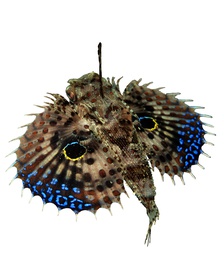Purple flying gurnard
Dactyloptena orientalis

(Image credit: David Harasti)
Easily identifiable by the huge pectoral fins which, when outspread, are rounded and spiked. When retracted the pectoral fins sit alongside the body and extend slightly past the tail. The body shape is elongated and box-like. The dorsal fin has been shortened to form one elongated spine that extends from the brow ridge.
Juveniles have a creamy white body with distinct large brown spots. Adults have creamy-white body but brown spots are smaller, more numerous and partially join to form dark areas. In adults the edges of the pectoral fins have thin blue lines running along the margins and are seen when the fins are extended.
The large pectoral fins are used to startle predators or for bursts of speed when leaving areas. The gurnard also has specialised pelvic fins that it can use to ‘walk’ across the sandy substrate. The fish is active at night and can be found partially buried during the day.
Contrary to the common name, the Flying Gurnard cannot fly. Gurnards get their name from the French word ‘gurnard’, which means ‘to grunt’. Gurnards produce a grunting sound from rubbing bones together in their jaw.
Length: Up to 35 cm
Habitat
Sandy slopes near deep water. Occasionally found in estuaries in areas with flat sandy bottom; 3-100 m depth
Log it
In New South Wales, log if spotted south of Bate Bay
Related links/info
Species names on the Redmap site are based on the Codes for Australian Aquatic Biota or CAAB (http://www.cmar.csiro.au/caab/). This is updated regularly and lists the approved common name, family, species name and more.
Redmap species descriptions were based, with permission, on the following resources:
Fishes of Australia’s Southern Coast, Edited by M. Gomon. D. Bray and R. Kuiter (2008) Reed Books, Melbourne
Find further information and images at FISHES OF AUSTRALIA http://www.fishesofaustralia.net.au/











